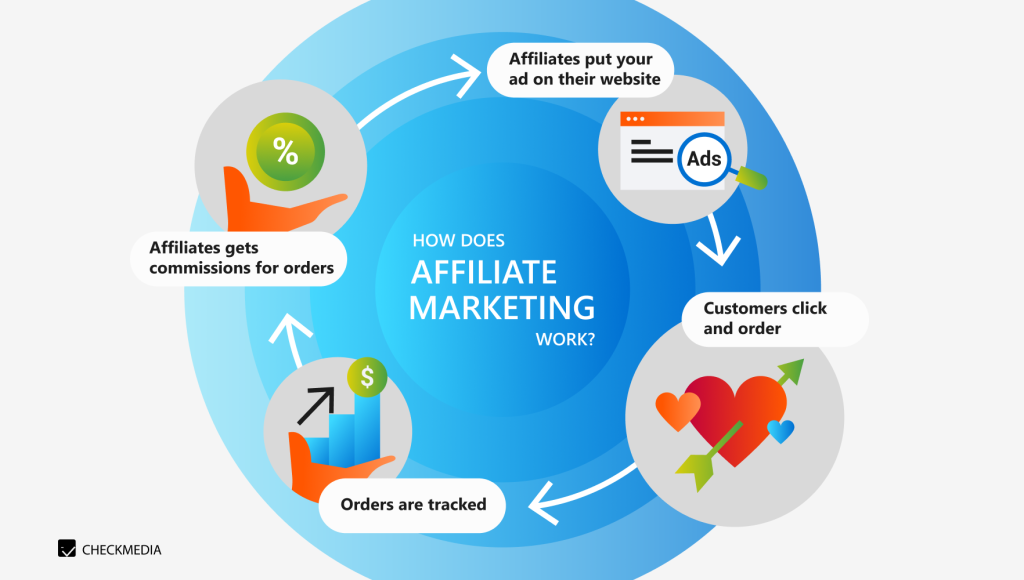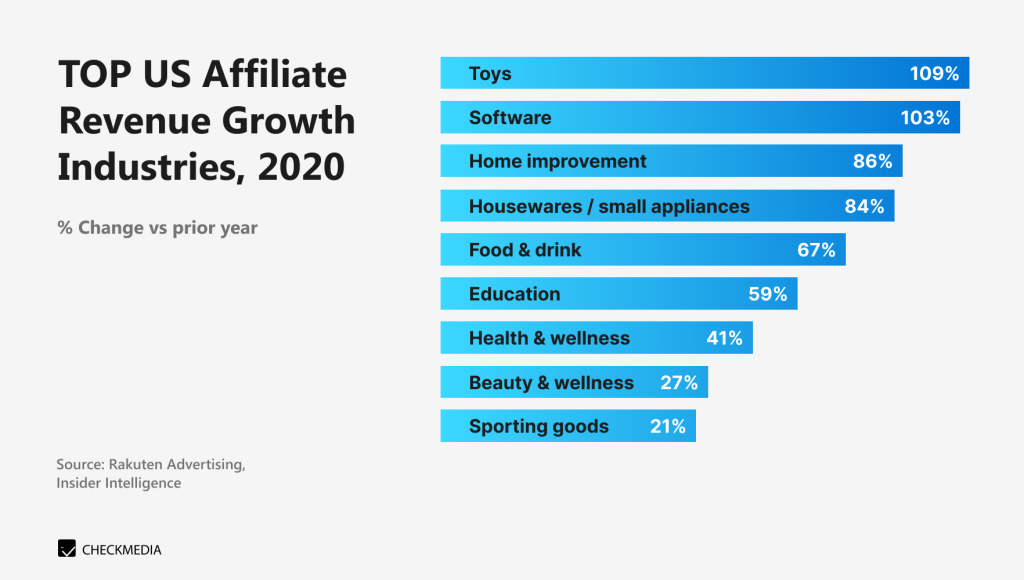
All about Online and Offline Affiliate Marketing Tools
Evolution of affiliate marketing
While affiliate marketing is now synonymous with the online realm, its roots stretch back to a time before the digital era. This promotion strategy is centered around drawing customers by rewarding those who vouched for a product. The first affiliate marketing program on the internet was initiated in 1989 by William J. Tobin for an online flower shop. Hosted on the Prodigy Network, this model rewarded Prodigy with a commission for each sale, and within just four years, it was generating over $6 million in annual sales via the platform.
One of the most successful cases of implementing affiliate marketing strategy is Amazon. They had recruited over 2 million affiliates worldwide in 1998 alone. Amazon has become a giant thanks to its partners showing the true power of this promotion model.
Today, affiliate marketing contributes to approximately 16-30% of digital marketing revenues. It now stands alongside email advertising, paid search, and social media promotions as a premier digital advertising strategy.
Affiliate marketing model

Affiliate marketing is a system in which a business rewards affiliates with a commission for each paying customer they bring. There are four key participants in the process:
- Merchant (also known as ‘brand’)
- Affiliate platform (medium to promote and sell products)
- Affiliates (people that promote the brand’s products)
- Customers
And that’s how it usually works:
- The merchant sets up a program where they define the conditions and commission structure for affiliates.
- Affiliates, often using unique tracking links or codes, promote the merchant’s products or services through various channels.
- When customers make a purchase, the tracking mechanism records this action, ensuring that the affiliate is rewarded with a commission.
Both the merchant and affiliates actively monitor the program performance, by tracking metrics such as conversion rates, click-through rates, and revenue generated. This data-driven approach allows them to evaluate the program’s effectiveness and optimize marketing strategies, enhance partner relationships, and maximize returns on investment.
Benefits of affiliate marketing
Many businesses seeking growth turn to affiliate marketing, largely because it offers a cost-effective route to higher ROI, enhanced brand visibility, and entry into new markets. Here are four key advantages of using affiliate marketing:
- Tailored Audience Reach: Since many content creators generate niche-specific content, businesses can align with those whose audiences match their target demographic. This ensures that products resonate with a more receptive crowd.
- Trust and Credibility: Influencers aim to win the loyalty and trust of their audience. Their endorsements remind word-of-mouth recommendations and can not only catalyze sales but also build brand awareness. When a recommendation comes from a trusted source, it bolsters a brand’s reputation.
- Measurable ROI: The nature of affiliate links enables businesses to trace every sale back to its origin, making ROI tracking straightforward.
- Cost efficiency: Often, this method is considerably more budget-friendly than traditional advertising channels, like PPC campaigns. The primary expenses are usually the specialized software and the commissions to affiliates who create cost-free promotional content for your brand, driven by their incentive to get as many sales as possible.
Is affiliate marketing suitable for your industry
Affiliate marketing is versatile and can be employed across a wide range of industries. However, certain industries have experienced particularly significant success with affiliate marketing, either due to the nature of their products, the behavior of their customer base, or the potential for repeat purchases. Here are seven business categories that hold a significant market share in affiliate marketing:
- Fashion and beauty: With numerous fashion bloggers and influencers, this industry thrives on affiliate marketing. Many influencers, especially on platforms like Instagram and YouTube, promote beauty products. A Chinese influencer known as the “Lipstick king” managed to sell $1.9 billion worth of goods in 12 hours.
- Sports and outdoors: Influencers can promote fitness programs and sports clothes.
- Health and wellness: This can include supplements, skincare, health foods, and even wellness apps.
- Travel and Tourism: Many hotels, airlines, and tour operators collaborate with bloggers and influencers who cater to travel enthusiasts.
- Home and garden: This includes furnishing, decor and gardening items.
- Computer and electronics: Influencers often review or promote the latest tech products, from smartphones to smart home devices offering personal links that guarantee a discount to buyers and a commission to the influencer.
- Education and training: This includes e-books, online courses, software applications, and membership websites. Given the easy distribution and scalability of digital products, it’s a very convenient way to earn commissions without dealing with the complexities of physical logistics.
According to Insider Intelligence, the two product categories that demonstrated the highest revenue growth in 2020, slightly over 100%, are toys and software.

It’s also worth mentioning that the overall retail industry is the most dominant sector for affiliate marketing. It accounts for 43% of total revenue affiliates make. Companies like Amazon have popularized it globally by their success. If your industry is one of those mentioned above, it’s high time to incorporate affiliate marketing into your promotional mix, if you haven’t already. While its effectiveness varies by region — with notable prominence in the US — it has proven impactful globally.
However, there are myriad other communication channels available, and most enterprises leverage a blend of these. Here are three sophisticated AI-driven tools for marketing budget management and optimization. By analyzing your historical data they can identify the channels that contribute the most to your KPIs as well as those wasting your money. Check out this comparison table and choose the most suitable one to ensure you minimize ad expenses while still hitting your sales and customer acquisition targets.
Alternatively, if you don’t have any historical data as you are introducing a new product or venturing into a new market, respond to 7 questions posed by our chatbot. This will help validate your go-to-market approach and learn if your allocated budget will suffice for a successful execution. Within a mere 5 minutes, you’ll also receive an industry-tailored optimal marketing mix created using a metamodeling approach.
Online affiliate marketing tools
As affiliate marketing proves to be an effective online customer attraction method, the industry expands, leading to the emergence of tools that streamline the process for all parties involved. Below are a few popular examples of such tools.
Link cloaking and tracking software
These tools are used to conceal long referral links and to track clicks and conversions. The software can also track important metrics such as referral source, geographic location, and time of click, allowing users to optimize their campaigns. Some popular link cloaking and tracking tools include Pretty Link, ThirstyAffiliates, and Clkim.
Affiliate marketing management platforms
These software tools help manage and optimize campaigns. They provide features such as program management, commission tracking, and reporting, as well as tools to recruit and manage affiliates. Some popular platforms include CJ Affiliate, Impact.com, and Post Affiliate Pro. These platforms usually offer a network of advertisers, making it easier to find and join relevant programs.
Comparison shopping engines (CSEs)
These websites allow consumers to compare prices for products from different merchants. You can use CSEs to promote products and earn commissions from sales. Some popular comparison shopping engines include Google Shopping, Shopzilla, and Bing Shopping. These platforms typically allow users to submit product data feeds and display product listings in a comparison format, making it easier for consumers to find the best deals.
Coupon and deal websites
They offer discounts and promotions for products and services. These websites can be used to promote products and earn commissions from sales. Most popular coupon and deal websites include RetailMeNot, Groupon, and Coupons.com. These platforms allow promoting discounts and deals to drive sales, and typically offer tracking and reporting features to help measure the success of campaigns.
Influencer marketing platforms
These software tools connect brands with suitable influencers. They allow influencers to earn commissions from sales made through their unique referral links, and provide brands and affiliates with a way to reach new audiences and drive conversions. Influencers might share a unique promo code that gives you a discount. Some popular examples of such platforms are AspireIQ, Upfluence, and Influitive. These platforms typically offer tools to manage and track campaigns, as well as influencer search and selection features to help brands find the right influencers for their campaigns.
Referral marketing software
Such tools are used by businesses to encourage existing customers to refer new customers to their products or services. Some popular referral marketing software includes ReferralCandy, Ambassador, and Referral Hero. These tools can help drive word-of-mouth marketing and increase conversions by leveraging the power of personal recommendations. Many banks stimulate existing customers to refer friends and family to open accounts or use some banking services. In return, both the referrer and the new customer often receive benefits, such as cash rewards, discounts on fees, or exclusive offers, fostering a sense of loyalty and encouraging word-of-mouth marketing for the bank.
Offline affiliate marketing tools
While affiliate marketing is typically associated with online activities, it is possible to adapt some of its principles for offline marketing efforts. Here are a few ways in which affiliate marketing can be applied offline.
While these offline affiliate marketing methods are feasible, they typically require unique tracking mechanisms to measure conversions accurately. Codes, phone numbers, custom landing pages, and dedicated phone lines are some ways to track the effectiveness of offline affiliate marketing efforts.
Print media partnerships
You can collaborate with print publications, such as magazines or newspapers, and offer them a commission for promoting you in their publications. They can include unique tracking codes or QR codes in print ads to measure conversions.
In-Person events and local sponsorship
If you attend trade shows, conferences, or other in-person events, you can establish affiliate relationships with promoters of your booth at these events. You can track referrals and sales through unique promo codes or forms. Partner with local organizations, clubs, or influencers to promote your business to their local audience. Offer them a commission for every sale or lead they generate.
Cross-promotion
Form partnerships with other businesses that complement your products or services. Cross-promote each other’s offerings to your customer bases. Gyms and spas, clothing and footwear stores, beauty salons and hairdressers are among the businesses that can effectively cross-promote, enhancing their customer reach by capitalizing on their related services.
Conclusion
The revenue from affiliate marketing has steadily increased by 10% annually since 2015, and this trend continues into 2023. According to the Wall Street Journal, the industry is expected to reach a value of over $27 billion by 2027. Successful examples of Amazon and other brands as well as statistics show that this type of marketing is a highly effective tool for driving sales so think about including it into your strategy. Especially if you are in the retail business, it could boost your business KPIs with the right approach and tools. The important thing is that any affiliate marketing program, whether online or offline, should be built on clear agreements, mutual benefits, and effective tracking methods to ensure fairness and success for all parties involved.



